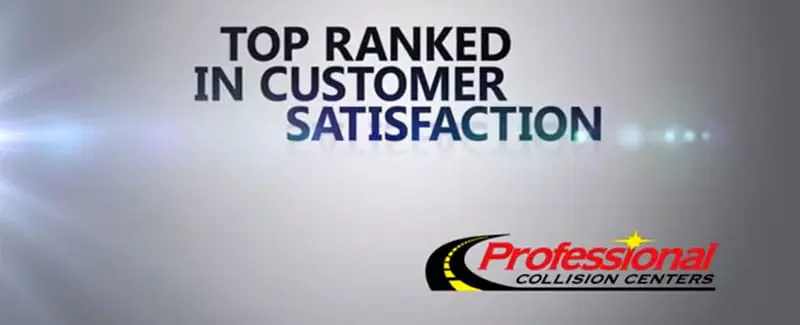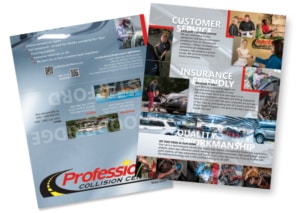Leveraging industrial photography for multiple media
A few months ago I wrote a post about how quality photography can make a difference in your marketing. Today’s post illustrates how animation (motion graphics) can take still industrial photographs and graphics to a whole new level.
My last post detailed how my creative partner, Sherri Arnaiz, and I partnered on a brochure for Professional Collision Centers. I did custom photography at their two locations. Those photos were used for a print brochure, their website, social media, and now they have become part of a 42-second video ad.
My experience in video production goes back as far as the mid-1990s. I worked for a large design and marketing company in Washington DC in those days. I made several short videos including:
- Logo animations
- Opening shows for conventions
- A PR piece for a railroad servicing company
Recently I have worked on 10 video eTutorials for a military contractor. These 5-minute video animations explain various concepts and topics to families of the deployed.
I also worked on a series of 9 elegant and artful videos for Light of Healing Hope Foundation. These videos were created to help heal people who are suffering from trauma and life-debilitating injuries.
What goes into a theater advertisement?
Theater advertising is unique in that people will see the ad run multiple times during their visit. People who come to the movies are there to be entertained. One of our goals was to make the ad memorable without being annoying—cute vs. obnoxious and in your face. Therefore, the music needed to compliment the visuals… It takes a lot of research to find the right piece that compliments the company and the ideas being presented.
This 42-second advertisement was similar to other videos I’ve worked on in the past with two exceptions. This video did not need narration or on-camera talent. This fact saved the client a lot of money and reduced the production time as well.
Just because it is short doesn’t mean it doesn’t get the same workflow as any other video. Sherri and I divided the workout as follows:
Stock research (video and audio)
Sherri took this part. The chosen stock video features a 5-second clip of a car driving through a city. The visual treatment includes streaks of nondescript lights zooming past the camera. This short clip would have taken me several hours to create because of the following:
- Location: A location where lighting that went as high as possible would need to be scouted. Part of the effect is the amount of area the light streaks take up in the frame. A couple of low-level building lights wouldn’t do.
- Vehicle and Road: A vehicle with a clean windshield driving on a road with little to no bumps. The amount of traffic that appears is also a factor. If the camera car were behind a car for too long, the viewer would look at the car model instead of the lighting effect. So Sherri found a clip that didn’t have any car in front.
I don’t want to go into it too far but you can see that in the time it took you to read this, that 5-second clip could have played 10 times. Taking 10-20 hours to produce that clip would not have been economical for the client. The takeaway is stock imagery and audio can save you money and can work well within the presentation if used sparingly. But it can also be troublesome as you will read shortly.
The research took several hours to complete. Sherri looked for video footage, video transitions, music, and sound effects. Unfortunately, researching this kind of thing is not a look-once and find-it process. It takes a long time to look and listen to each video or audio clip. You may never find just the right one that will work in your situation. We knew that this advertisement would be viewed with others and shown twice before the feature movie began. We didn’t want music that was going to be irritating after hearing it the first time or even the second time. So there are compromises.
Graphic Design
Sherri figured out what key points the commercial needed to get across to the viewer and developed eight screens of text art. She selected a bold font because the audience had to be able to read it quickly. Each phrase had to be short and digestible within two seconds. The letters were spaced so each word could be easily read and were scaled to fit well within a zone that guarantees the text will not be cut off.
This theater ad was going to be viewed on an IMAX screen. We didn’t want the viewer to have to look from one side of the screen to the other and back again to read it. They needed to understand it in a glance so the message needed to occupy a small area.
Because of the deadline, our normal workflow was shortened and we didn’t make a traditional hard copy storyboard.
Video Editing
It’s difficult to call this video editing because there is very little video in this project. It’s motion graphics: animation of static elements.
While Sherri was getting client approval, I began setting up my video file. The requirements for theater advertising are very similar to iTunes requirements. The dimensions are very large, the audio bit rate and color depth of the images are high, and it requires color management. In short, it is very taxing on a computer system as opposed to some other forms of video.
I went back to the original photos I shot for this client and exported a set of images using the appropriate bit depth. I didn’t want to use JPEGs since I had the original photographs which were more video-friendly.
Approved!
The idea Sherri pitched to the client was approved and so we got moving. Sherri sent me files for each screen, stock audio and video, and made selections from the photos I shot. I began to piece the elements together.
The stock transition that we chose had a lot of parts to it. This brings up an issue with stock. While they may save you some time, they can be difficult to work with. You have to learn how the author intended for the imagery to be used. You have to pick it apart and figure out how to make it work for your animation. I was eventually able to figure out a way to make the stock video transition work. It may not have been my preferred method, but it worked (he says as he throws the Scotch tape into the box).
Discovery
Something that happens during the editing phase is you discover the way audio, video, and stills work together. It is something that cannot be storyboarded—it has to be discovered. Our original concept, if storyboarded would have shown eight text screens with a photo in-between each. After I put the music into it, I noticed the rhythm and the different points in the score that indicated a transition. I counted them out and it looked like I was only going to be able to get six text screens in. The reason being is if I just put all eight in, yes, they would have fit the timeline but they would not have fit the music. Fitting them to the music was more important because it would feel right to the viewer if the text followed musical cues.
By making the visuals and audio flow in sync, it gains a polish it would not have had by simply following a storyboard. As it turned out, I was able to get seven of the eight screens into that clip of music. I had one more piece of music to finish the ad off with and it was originally going to go under a video of a car going off in the distance. As it turns out, we scrapped that idea and inserted the 8th text graphic to hold to the end. It worked perfectly.
We wanted the audience to be entertained by this ad since they would be sitting in a movie theater. It had to have some aspect of “music video” to it so they would want to watch it even though they were a “captive” audience.
The playfulness of the video can be attributed to the last audio track. This is where good stock research, and the time it takes, pay off.
Have fun and enjoy the show.


